BM-21A / B "BelGrad" - Belarusian version of the modernization of the Soviet MLRS
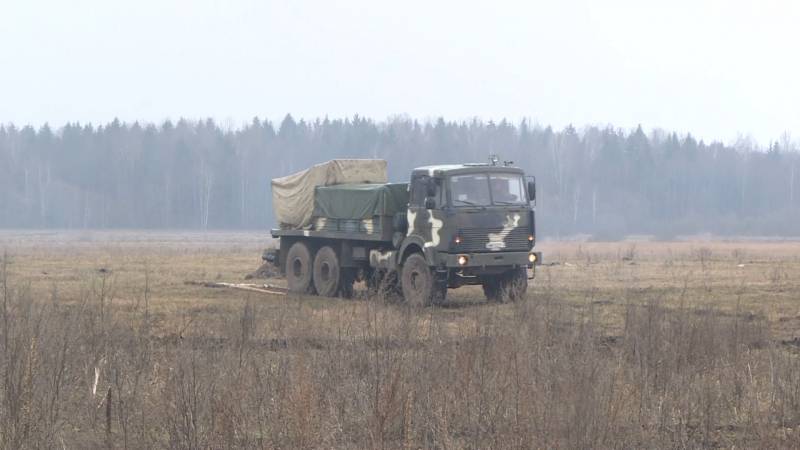
BM-21A "BelGrad" in the stowed position
Multiple launch rocket systems BM-21 "Grad" of the Soviet design and production are in service with many foreign countries. Some of them are trying to refine such a technique in accordance with their requirements and views. So, in the interests of the Belarusian army, two projects for the modernization of the Grad were developed under the designation BM-21A / B or BelGrad.
In response to obsolescence
With the collapse of the USSR, the independent Republic of Belarus got a fairly large fleet of military equipment. In particular, it included about 300 combat vehicles of the Grad multiple launch rocket system. They were credited to the balance of the newly created Belarusian army and continued to operate in the normal mode.
However, already in the mid-nineties, it became necessary to modernize or replace such equipment. The existing "Grads" were not distinguished by their small age and had already managed to develop a significant part of the resource; first of all, this concerned the chassis of the Ural brand. In this regard, it was decided to develop a BM-21 modernization project with the replacement of the base vehicle. In addition, fire control systems, communications, etc. should have been updated.
The modernization project received the designation BM-21A and the name "BelGrad", indicating the original sample and the country in which its updated version was developed. The work started in 1997 and was carried out by several organizations. With the development of such a project managed to cope in just a few months.
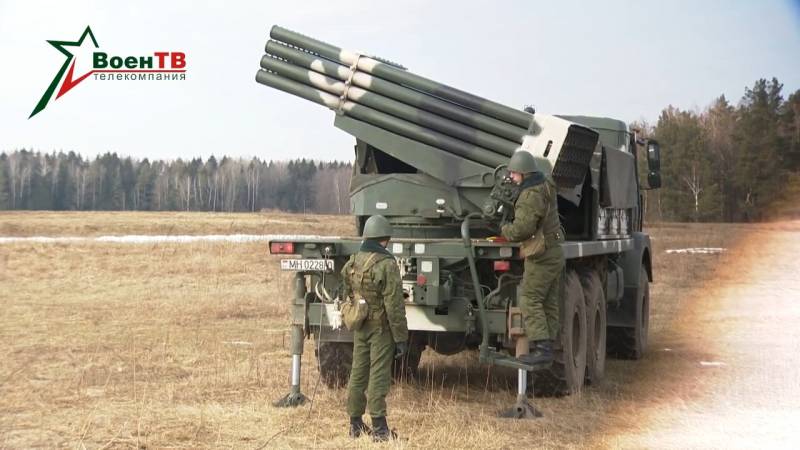
Preparing for shooting. Visible modified gunner's workplace and jacks
The overall coordination of work on the project was carried out by the Scientific and Technical Committee of the Ministry of Defense, individual units were created by the Military Academy of the Republic of Belarus and other organizations. The chassis was provided by the Minsk Automobile Plant. The 2655th plant for the repair of electronic weapons (Borisov) was attracted as a manufacturer.
The prototype was ready and went for testing at the end of December 1997. Various checks, test firing and fine-tuning of the design continued over the next few years. Probably, both the certain complexity of the project and the introduction of new functions and capabilities affected.
The work was generally completed in 2001. In August-September of the same year, the upgraded MLRS took part for the first time in the exercises of the Belarusian army "Neman-2001". Shortly thereafter, the BM-21A was officially put into service, and the 2655th plant began deliveries of serial equipment.
According to known data, in the following years, the Belarusian industry rebuilt a significant part of the existing Grads according to a new project. At the same time, for one reason or another, the total number of MLRS had to be reduced, sending part of the equipment for storage. According to known data, up to 125-130 units are currently in active operation. BM-21 of all versions.
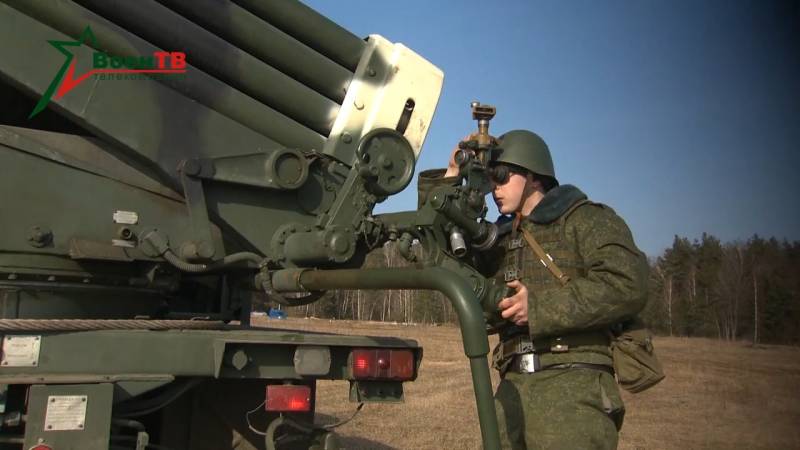
Replacement and rebuilding
The main objective of the BelGrad project was to replace the standard chassis with an affordable model. Based on the results of the analysis of the available opportunities, it was decided to use a three-axle vehicle MAZ-631705 of Belarusian production. The characteristics of such a chassis made it possible not only to transfer the artillery unit, but also to introduce some additional features.
MAZ-6317 is a three-axle all-wheel drive off-road truck. The machine is built according to the cabover scheme and has a cab above the engine. In modification "05", the chassis was equipped with a YaMZ-238DE2 diesel engine with an HP 330 power. The engine is mated to a 9-speed manual gearbox. Gross weight - more than 25 tons, carrying capacity - 11 tons.
The chassis has a cargo platform 6,25 m long. A full-time artillery unit of the Grad is mounted in its stern. Hydraulic jacks are also installed to stabilize the chassis when firing. The free space between the cockpit and the launcher was given over to racks for additional ammunition. Part of the combat vehicles received 9F37 racks for 40 missiles, others - 9F37M products for 60 cells. The racks were borrowed from standard transport-loading vehicles from the Grad system.
The missile launcher has been slightly modified. She kept 40 tubular rails in a single package. At the same time, due to the greater height of the chassis, a bracket with a platform for the gunner was installed on it. In the guidance mechanisms, new limiters for angles and speeds appeared. Copiers and stops also appeared, protecting the cab from being hit by guides.
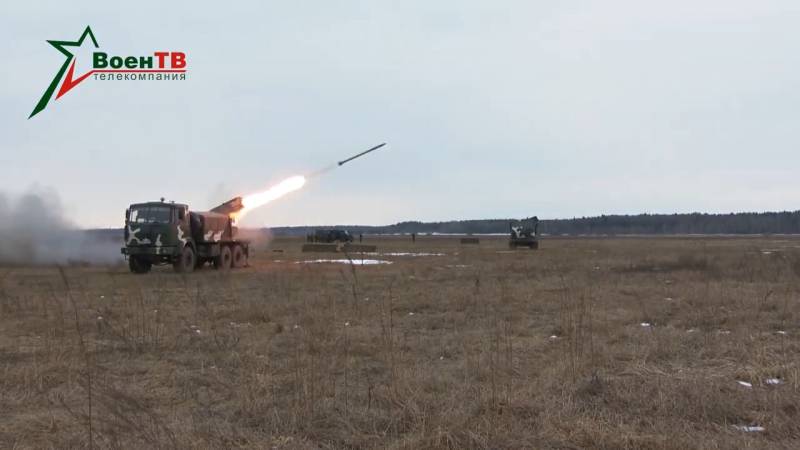
Battery "BelGradov" is firing
A modern radio station appeared on board the BM-21A. The fire control facilities and the electrical system of the artillery unit were modified taking into account the requirements and characteristics of the chassis. The fire control panel can be used in the cockpit or removed to fire from a safe distance.
The modernized "BelGrad" retained the previous package of guides and could use the entire range of 122-mm Soviet-designed unguided projectiles. Fire characteristics and combat capabilities remained at the level of the base MLRS BM-21. So, the maximum firing range exceeded 20 km, there were shells with high-explosive fragmentation, cluster, incendiary and other equipment.
The calculation of the BM-21A consists of five people. All operations for loading, getting into position, preparing for firing, etc. are carried out by the calculation forces using the standard means of the combat vehicle.
Modern modernization
In May 2020, the 2655th plant began to develop a new modification of the BM-21. This project was designated BM-21B or "BelGrad-2". In December of the same year, a prototype of such a MLRS first entered the range and fired. At the same time, the Belarusian Ministry of Defense for the first time spoke about the existence of such a project.
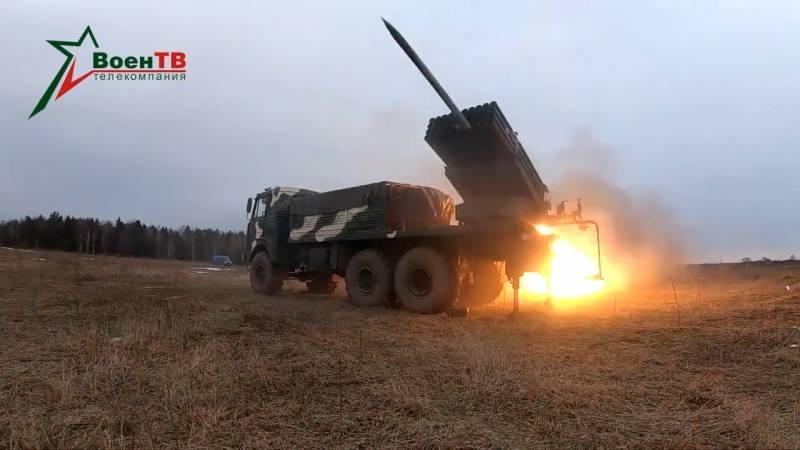
During the spring and summer of 2021, the updated BM-21B passed factory and state tests. The technique confirmed the calculated characteristics and was highly appreciated. In June of the same year, BelGrad-2 was first shown to the public at the Milex-2021 exhibition in Minsk. It is known that at that time the issue of adopting a new MLRS for service was being decided. However, exact information on this subject has not yet been received.
The new BelGrad-21 differs from the BM-2A in several systems and devices. So, the equipment of the cabin was redesigned. A reduced calculation of four people is completely located in it. A remote-controlled leveling system has also been introduced. It includes sensors and actuators that give high accuracy. There is no need to leave the cabin. Instead of a regular radio station, a full-fledged communication complex was installed with the possibility of voice communication and data transmission.
The BM-21B continues to use the old 122mm shells of all types. It was also reported on the development of new ammunition, such as 9M521MB or 9M522MB. With the same dimensions and similar weight, they carry a detachable warhead, incl. with a radio fuse. The firing range of such missiles reaches 35-40 km.
Consistent development
Thus, over the past decades, the Belarusian defense industry, on its own, has consistently carried out two modernizations of the existing Soviet-made MLRS BM-21 Grad. These projects are of particular interest from a technical point of view, and also show possible ways and means of developing old technology.

The first Belarusian project BM-21A "BelGrad" was developed in connection with the expected problems with the operation of standard chassis. Its developers found a modern replacement for the old Ural, and the chosen chassis, due to its higher performance, made it possible to increase the ammunition load. However, other innovations were also needed, such as new means of stabilization.
The modern project BM-21B "BelGrad-2" offers an update of electronic means, and also expands the ammunition load, which improves the overall combat qualities of the MLRS. In fact, this is a direct analogue of the Russian Tornado-G system, which appeared at the beginning of the last decade.
In general, the chosen ways of developing the original design look correct and useful. Two BelGrad projects made it possible to get rid of future problems, gain new opportunities and improve the main characteristics of cash MLRS. At the same time, the Belarusian industry did not have to develop new projects from scratch or create particularly complex components and tools.
According to known data, in the nineties and two thousandths, the rocket artillery of Belarus completely transferred rocket artillery from the old Grads to the new BM-21A. Now, apparently, the cash Belgrades are being upgraded to the BM-21B. Thanks to this, the ground forces improve and increase their firepower - and this development does not cost extra.
Information